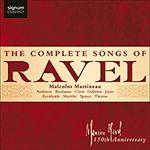
Welcome to Hyperion Records, a British classical label devoted to presenting high-quality recordings of music of all styles and from all periods from the twelfth century to the twenty-first.
Hyperion offers both CDs, and downloads in a number of formats. The site is also available in several languages.
Please use the dropdown buttons to set your preferred options, or use the checkbox to accept the defaults.

| John Chest (baritone), Malcolm Martineau (piano)» More |
The songs portray the noble lunatic as lover, holy warrior and drinker, and Ravel with typical fastidiousness chose three distinct types of dance rhythm to illustrate these facets. The first, Chanson romanesque, is a quajira, a Spanish dance with alternating bars of 6/8 and 3/4. The harmonic progressions and the grateful curve of the melody recall Ravel’s beloved Chabrier with a simplicity of means that has little in common with the style dépouillé. The song ends with the apostrophe ‘Ô Dulcinée’, as blind love overwhelms the verbal conceits. For the Chanson épique Ravel chose the 5/4 of the Basque zortzico. Here the chordal accompaniment and modal inflections recall not so much Chabrier as Ravel’s teacher Fauré. The final Chanson à boire celebrates the only real attribute of the Don, and Ravel accentuates this realism both by the cumulative, insistent cross-rhythms of the jota and by a strictly strophic setting of the two verses. Cunningly, he manages to build into the music the longueurs and exaggerations typical of the drunkard.
from notes by Roger Nichols © 2009
Don Quichotte à Dulcinée, sont le fruit d’une commande pour un film consacré au chevalier espagnol et réalisé par le cinéaste autrichien Georg Pabst, avec Chaliapine dans le rôle titre. Le contrat signé en juin 1932 spécifiait qu’une sérénade, une chanson héroïque et une chanson comique devaient être remises au plus tard au mois d’août , et précisait que Chaliapine préférait ne pas avoir à chanter trop de do, ré ou mi bémols aigus. En l’occurrence, Ravel a tardé à livrer sa commande et c’est Ibert qui a été sollicité pour le film.
Dans ces mélodies, le noble fou est présenté comme un amoureux, comme un soldat en guerre sainte et comme un buveur. Avec ce côté méticuleux qui le caractérise, Ravel choisit trois types de rythme de danse distincts pour illustrer ces facettes. La première, la Chanson romanesque, est une quajira, danse espagnole avec des mesures alternées à 6/8 et 3/4. Les progressions harmoniques et la courbe agréable de la mélodie rappellent Chabrier, cher à Ravel, avec une simplicité de moyens qui n’a presque rien en commun avec le style dépouillé. La mélodie s’achève sur l’apostrophe «Ô Dulcinée», l’amour aveugle submergeant les afféteries verbales. Pour la Chanson épique, Ravel a choisi le 5/4 du zortzico basque. Ici, l’accompagnement harmonique et les inflexions modales ne rappellent pas tant Chabrier que Fauré, le maître de Ravel. La dernière mélodie, la Chanson à boire, célèbre le seul véritable attribut de Don Quichotte, et Ravel accentue ce réalisme à la fois par les contre-temps cumulatifs et implacables de la jota et par une mise en musique strictement strophique des deux strophes. Il parvient avec habileté à glisser dans la musique les longueurs et exagérations typiques de l’ivrogne.
extrait des notes rédigées par Roger Nichols © 2009
Français: Marie-Stella Pâris
Die Lieder stellen den noblen Verrückten als Liebenden, heiligen Krieger und als Trinker dar und mit seiner charakteristischen Gründlichkeit wählte Ravel drei spezifische Tanzrhythmen, um diese verschiedenen Eigenschaften zu illustrieren. Das erste Lied, die Chanson romanesque, ist eine quajira, ein spanischer Tanz mit alternierenden Rhythmen von 6/8 und 3/4. Die harmonischen Fortschreitungen und die dankbare Melodiekurve erinnern an Ravels geliebten Chabrier mit einer Schlichtheit, die jedoch mit dem style dépouillé nicht viel gemein hat. Das Lied endet mit dem Ausruf „Ô Dulcinée“, wenn blinde Liebe verbale Einbildung besiegt. Für die Chanson épique wählte Ravel den 5/4-Takt des baskischen zortzico. Hier erinnern die akkordische Begleitung und die modalen Wendungen nicht so sehr an Chabrier, sondern eher an Ravels Lehrer Fauré. Das letzte Lied, die Chanson à boire, zelebriert die einzige wirkliche Eigenschaft des Don und Ravel betont diesen Realismus sowohl mit kumulativen, insistierenden, gegeneinander gesetzten Rythmen des jota als auch mit einer strengen strophischen Vertonung der beiden Verse. Es gelingt ihm, geschickt die typischen Längen und Übertreibungen eines Betrunkenen in Musik umzusetzen.
aus dem Begleittext von Roger Nichols © 2009
Deutsch: Viola Scheffel
 Ravel: The Complete Songs Ravel: The Complete SongsA double album presenting—in chronological order of composition—all forty-seven mélodies by Maurice Ravel, Malcolm Martineau accompanying a small army of the finest soloists. (Listeners should be aware: these recordings were set down over a number ...» More |

